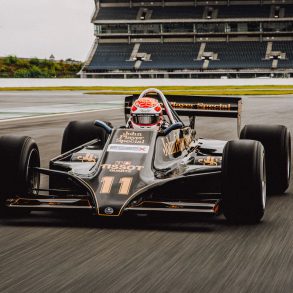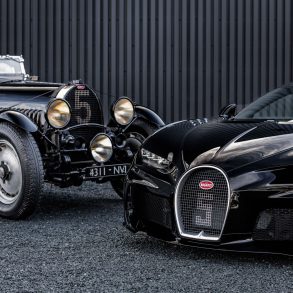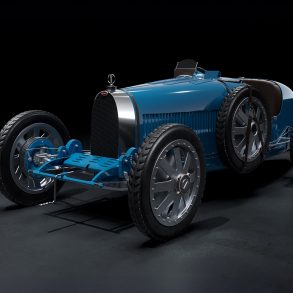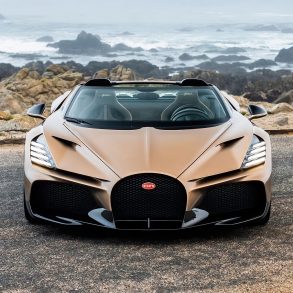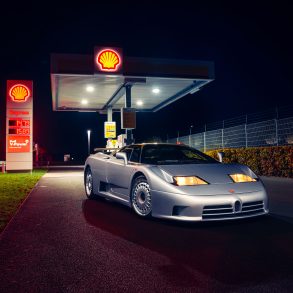Bugatti Type 32
Car: Bugatti Type 32 / Engine: Inline-8 / Maker: Bugatti / Bore X Stroke: 60 mm x 88 mm / Year: 1923 / Capacity: 1991 cc / 121.5 in / Class: Grand Prix / Power: 100 bhp / 75 KW @ 4,900 rpm / Wheelbase: 2020 mm / 79.5 in / Track: Front: 1052 mm Rear: 1052 mm / Weight: 660 kilo / 1,455 lbs / Top Speed: 189.9 kph / 118.0 mph
This aerodynamic tank-shaped Bugatti that competed in the 1923 French Grand Prix was the predecessor of the famous Bugatti Type 35. Its profile was shaped like an airplane wing and was intended to provide downforce. The wheelbase was only 2020mm long; by comparison the Delage 2LCV’s wheelbase was 2600mm.
The car’s wheels and radiator were completely covered by the bodywork which was riveted to the frame. The Tank de Tours was a primitive attempt by Bugatti at race car aerodynamics, unfortunately his understanding was incomplete and the shape of his car actually worked at cross purposes. In a statement released to the press before the French Grand Prix, Ettore Bugatti stated “the more closely a vehicle approaches the ground, the less will be it’s resistance to forward motion.” While being low to the ground the shape over the top surface was similar to that of a wing and flat bottom actually generated lift at high speed! He seemed to not be familiar with the ‘Bernoulli Principle’ named after Daniel Bernoulli who published his famous principle in his book Hydrodynamica in 1738.
Perhaps had Bugatti turned his body upside down and possibly made his race car even uglier he would have had more success. The car however is a good example of how Bugatti approached race car design, intuitively. Bugatti abandoned his pursuit of aerodynamics only to resurrect some of his ideas with the Type 57G Tank of the late 1930s. Another interesting aspect of the car was its front brakes. Thanks to a special brake master cylinder the front brakes featured hydraulic assist but the driver had no actual brake pedal to operate, have to make due with a lever. The Bugatti’s drivers complained that the cockpit was cramped, claustrophobic and hard to see out of, for American readers this would be akin to a “12-year old trying to see over the dashboard of Dad’s Oldsmobile”. Just to make matters worse there was no bulkhead allowing his drivers to be fully assaulted by the car’s engine, from T30 of the previous year and still underpowered when compared to those of the competition, especially the supercharged Fiats.
The French Grand Prix, held near Lyons on a hot and sunny day in July started at 8 am when the cars were released via a rolling start. The course was 14.18 miles of which the drivers would lap 35 times. The circuit was said to be narrow and bumpy with a poor road surface. There were 17 entries including Fiat, Sunbeam, Delage, Rolland-Pilain Voisin and the Bugattis. Notwithstanding the car’s shortcomings, a superb duel ensued between Ernest Friedrich, Bugatti’s long-time mechanic driving the No. 6 Bugatti, and the Voisin Laboratoires which offered some excitement for the French crowd.

On the last lap the third Sunbeam of the race leading trio spun when his clutch slipped and allowed Friedrich to take a superb third place after the three other Bugatti cars had retired due to accidents or mechanical problems. At the very first corner Bugatti No. 11 driven by Pierre de Vizcaya misjudged the hairpin and went off the road hitting a tree and severely injuring several spectators. What happened to Bugatti No. 16 Pierre Marco is uncertain, but perhaps he just thought better of it.

A T32 appeared at the Boillot Touring Cup race for sports cars but was forced to retire after a crash. Friedrich’s car was sold to a Czech banker, Cenek Junek, who entered and won a few hillclimbs. The car was replaced only after being raced for the one year. During that year, except for the hillclimbs, little success was had. The motoring press jumped on Bugatti’s race car, criticizing not only the car’s anemic performance, but also its bizarre styling. Following the Tank, Bugatti released an entirely new Type, one with more traditional styling, which he hoped would boost lagging sales. Little did Bugatti or anyone who was in attendance on the 2nd of July would have guessed that the Bugatti Type 35 would become the most successful racing design in history, and after the ugly duckling T32, one of the most beautiful as well.
More Bugatti models








